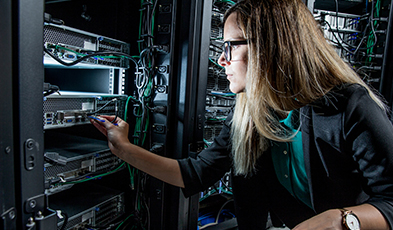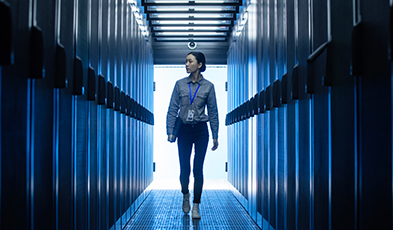Data centers consume a lot of energy; some say it can be as much as 4% of the total greenhouse emissions worldwide.
It’s why power consumption, cooling costs, and space requirements are at the heart of the sustainable data center. Technological advancements in virtual and intelligent rack power distribution units (PDUs), branch circuit monitoring, and computer devices can provide some efficiency, but a lot more is needed to not only reduce the data center’s carbon footprint, but to rein in skyrocketing costs.
The cost to power a single server rack in a data center in the US, for example, can be as high as almost $30,000 a year, depending on its configuration. By this measure, an organization with 100 cabinets could spend more than $3 million per year on data center energy alone. It’s one of the main reasons more IT professionals are zeroing in on monitoring energy consumption and operational efficiency.
You Can’t Reduce What You Can’t Measure
There are two main energy consumption sources for a data center: the operation of IT infrastructure and the use of cooling systems. According to research, anywhere between 30% to 55% of a data center’s energy consumption goes into powering its cooling and ventilation systems — with the average hovering around 40%.
Hitachi Vantara has been building eco-friendly infrastructure for years, which has helped organizations change their green profiles while lowering the costs of running their data centers. Our data storage systems enable people to both lower the amount of electricity needed and lessen the amount of floor space needed – each of which lessens the amount of cooling required. For example, the Hitachi Vantara VSP series continues to reduce CO2 emissions by 30% to 40% with each new product introduction. In fact, one global customer leveraged these systems to help reduce both its energy and carbon emissions by 96%. You can read the case study here.
Visibility into performance is also needed for making capital outlay decisions, as well as for data-to-day decision making to optimize operations. Analytics is one way to help the human in the loop make better and more timely decisions on how to improve power consumption, cooling costs, and space requirements.
Disparate storage can become inefficient when underutilized, wasting capital investment and consuming power, cooling, and space resources unnecessarily. The same can be true for legacy storage systems that typically require and consume more energy than more modern equipment.
Compounding the challenge of legacy equipment is the fact that many data center floors and storage implementations have been configured without adequate consideration of heat distribution. As a result, although sensors can identify hotspots and report events and adverse conditions, once equipment has been put in place, they’re difficult to move or update without disrupting applications.
Generally speaking, IT equipment can tolerate wider ranges of humidity, which saves in cooling costs. And the use of sensors and controls can match cooling capacity & airflow with IT loads. Furthermore, DataOps practices can be applied to converge IT and building facilities functions so that energy, equipment and floor space are used as efficiently as possible. In other words, analytics can allow you to “right-size” the infrastructure and reduce energy costs.
Lumada Industrial DataOps for Energy Optimization
When it comes to the green enterprise, the reality is that energy efficiency is rarely part of an IT professional’s formal training. So, introducing basic energy efficiency concepts can get your colleagues thinking about ways to save. These procedures can be augmented by bots or energy advisor applications driven by AI to give prescriptive advice to personnel around optimization opportunities in real-time.
Hitachi Vantara’s Pentaho platform software provides observability of operations and assets for optimization. Dashboards are configured to understand power usage, related also to A/C, especially the largest hardware boxes closest to AC ducts, for most efficiency. Hitachi Vantara conservatively estimates data centers can save 0.5% to 2% of overall energy costs by using the monitoring solution, while industry experts estimate that general facilities efficiency savings of as high as 10% to 15% are possible from IoT monitoring.
Integration to existing systems is no problem as Lumada supports streaming protocols from IT and OT systems including OPC-UA, SNMP, HTTP, Modbus, BACnet. It can also interface into existing data center management and services applications like DCIM and ERP systems.
IIoT Core software is the server, the main product for controlling, visualizing, and configuring the monitoring. The Edge Connect software sensor blocks are the sensors that are sending data into the server. An Edge Connect Site is the site (data center) that we’re connecting to. The Edge Manager is the piece that allows us to take in the edge data, from sensors and site systems as well as other sources like BACnet for building information (HVAC, building management software) and other protocols, to feed them into the IIoT Core.
Dashboards are custom built to your exact requirements using Pentaho Business Analytics, or a dashboarding technology of your choice like Grafana or Power BI. Observability, visualization, and Insights are provided along with log, trace and event data from connected devices, storage, software applications running on-prem or in the cloud. Contextualized and visualized Insights give the knowledge to make optimization decisions in real-time as well as for planning activities.
In addition, asset optimization can be enabled via forecasts, predictions, and recommendations based on asset usage, location, or performance for informed decisioning. Process optimization can also provide recommendations for process optimization.
A Lot to Consume
The first step to driving a more sustainable data center is to understand your current energy consumption – this should be done before ever embarking on a plan to reduce energy and carbon emissions. Once you have a consistent overview, you can start the hunt for energy and carbon emission efficiency opportunities. We know of many projects where modernizing the infrastructure can lead to a substantial reduction of up to 96% on electricity and CO2.
Pentaho platform is an open framework with integration to datacenter facilities of any kind. Often we are met with unique components such as cooling systems or legacy management software, which are different from standard computing and storage integration. Here our open and custom-made connectors create value. With a single overview we can give you insight to the energy consumption for the entire product fleet.
The tools are here. The expertise is here. There’s no reason to delay your move to a more sustainable, eco-friendly data center.
Steven Garbrecht is Director, Industrial DataOps, Hitachi Vantara.
Tom Christensen is Global Technology Advisor and Executive Analyst, Hitachi Vantara.


